Sourdough bread is even more delicious when it's loaded with briny olives, crunchy walnuts and sweet roasted garlic!
This olive and walnut sourdough bread can be served alongside soups or enjoyed as a hearty snack all on it's own!
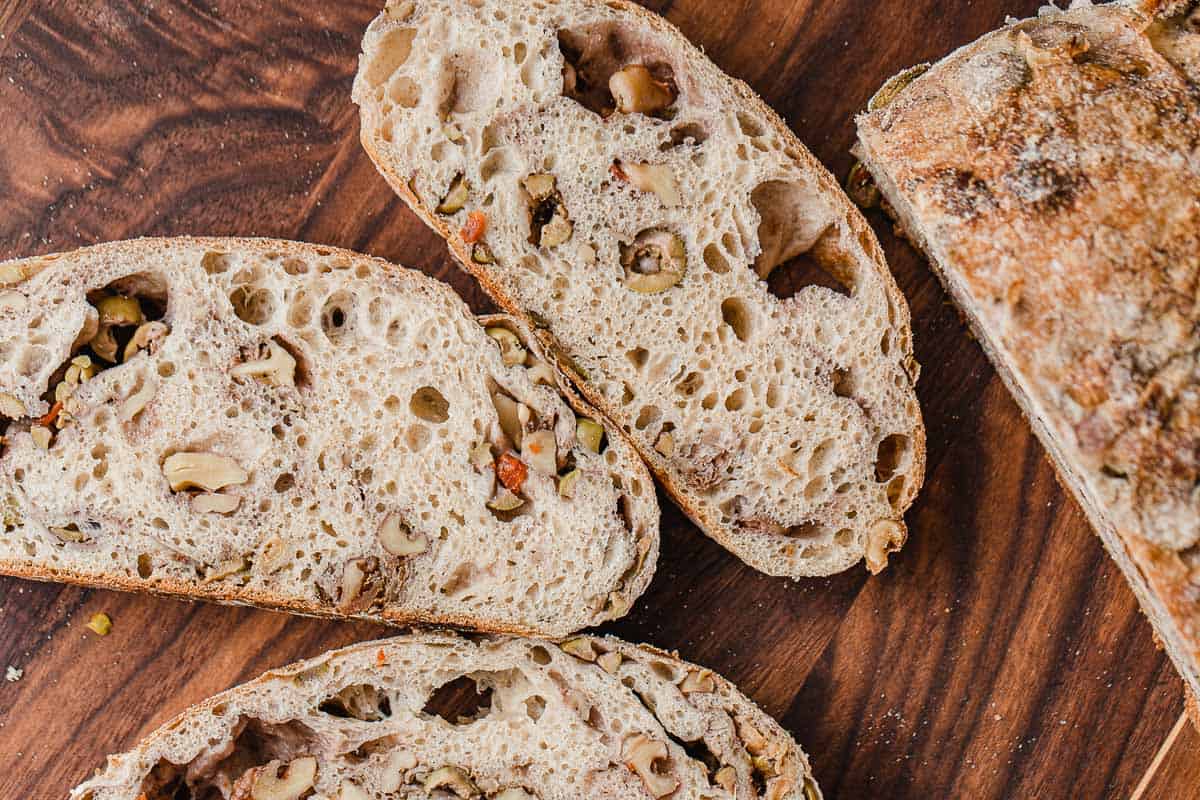
I'm giving you fair warning, you won't be able to eat just one slice of this olive and walnut sourdough bread.
Not only is it beautiful to look at, but every bite is filled with exciting flavors and textures for a truly unique sourdough experience. It is INSANELY delicious!
This is our basic sourdough country loaf recipe with the addition of olives, walnuts, roasted garlic and dried basil, which are added to the dough in the second set of stretch and folds.
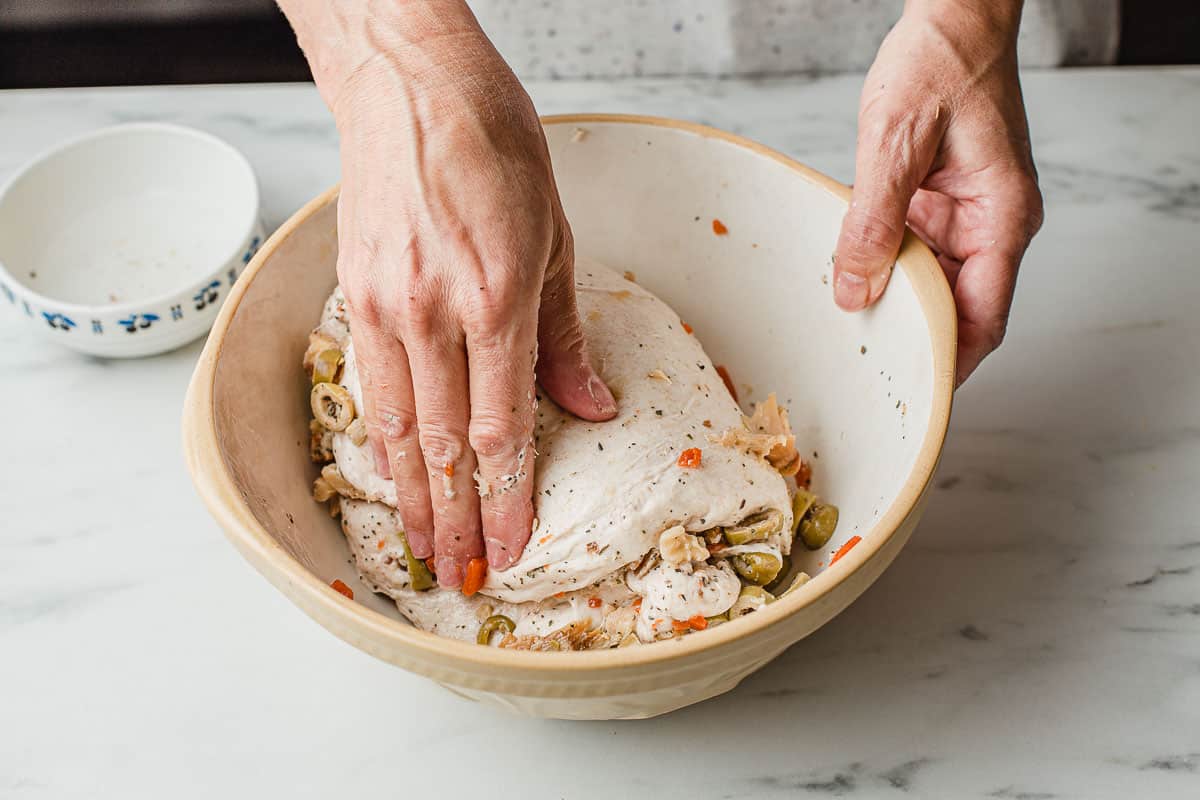
Mix this dough up in the morning and you'll be enjoying it at supper time!
Let's get to mixing!
Step by step instructions
This is a super easy sourdough recipe. Let's take a look at the steps!
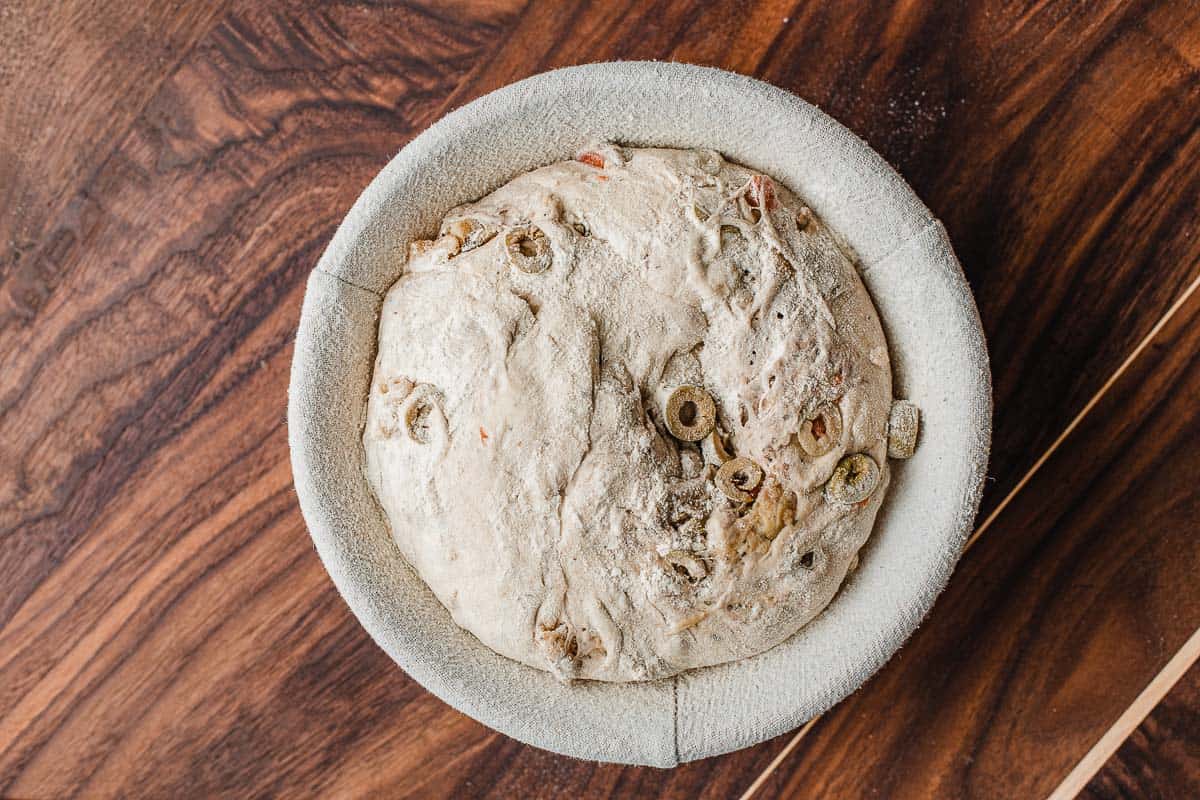
- Sourdough Starter - Feed your sourdough starter 4-12 hours before you plan to mix your dough so that it's bubbly and active.
- Autolyse - Use your hands to mix the flour, sourdough starter and water in a large bowl until there are no dry bits. Cover and let rest 1 hour.
- Add salt - Add the salt to the dough and work it in using your hands until well combined. Cover and let rest 1 hour.
- Bulk fermentation - Perform 3 sets of stretch and folds, 30 minutes apart, over the first hour and a half. Add the olives, walnuts, roasted garlic and dried basil to the dough during the second set of stretch and folds. Cover the dough and allow to ferment at room temperature for an additional 2-3 hours.
- Shape and Second Rise - Turn the dough onto a floured surface and shape into a rough ball. (It will not be smooth). Flour the top of the dough and place in proving basket, top-side down. Allow to rise at room temperature for 2-3 hours or until it has risen about 20%-30%.
- Score and bake - Preheat oven. Score the loaf, spritz lightly with water and bake.
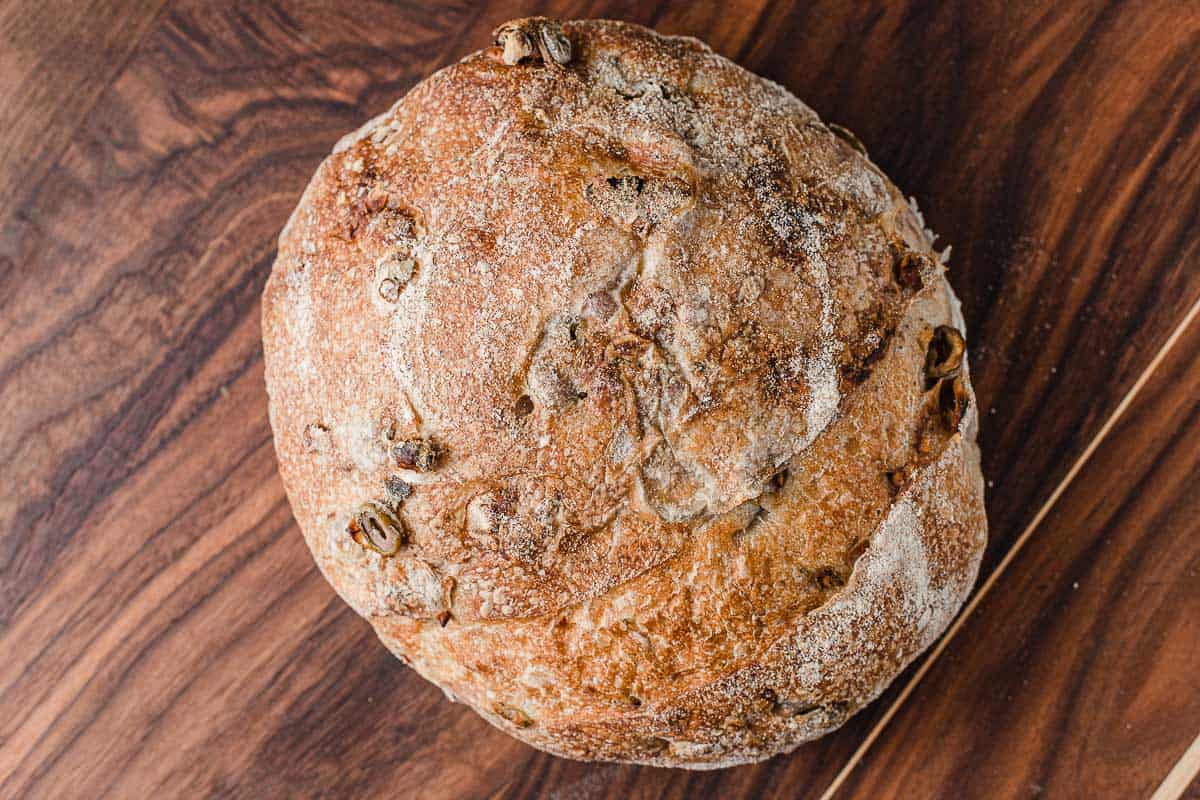
Tips for success
PREPARE SOURDOUGH STARTER
The optimal time to mix your sourdough bread dough is when your sourdough starter is at it's peak of activity.
Count how many hours it takes for your starter to peak after you feed it and use that information to adjust your baking schedule.
TIPS ON SHAPING THE LOAF
Normally, when shaping sourdough for the final rise, the dough would be shaped twice. However, this dough is shaped once.
After dumping the dough onto a floured surface, flour the dough and use your hands to twist it on the surface to form a rough shaped ball. Use a bench scraper to pick the dough up and turn it over into the floured proving basket.
After you shape the dough into a ball for the final rise, it will be rugged and lumpy in appearance, which is different from the sourdough country loaf.
Do not worry that the surface of the dough does not have a taut skin. This will be a much more "rustic" looking loaf that the original country loaf.
Tips for baking in warm and/or high humidity areas - When baking in high humidity and/or warmer areas, it's often a good practice to use less water and bake a little longer than the recipe calls for. Reduce the water by 50 grams in the initial mix and then slowly add the remaining water until you achieve the correct hydration level. Bake the bread about 5-10 minutes longer with the lid on, remove the lid and bake until done. This will take some trial and error!
Don't have a kitchen scale to measure flour?
Use the scoop and level technique to measure your flour if you do not have a kitchen scale. To do this, use a spoon to fluff up the flour in the bag. Use a spoon to scoop the flour into a measuring cup until it is heaped on top. Take a butterknife and level off the top. This should give you the most accurate measurement for flour.
Because flour is measured by weight in these recipes, if the flour is scooped straight out of the bag with the measuring cup, there will be more flour than is called for in the recipe.
INGREDIENTS
Green pre-sliced manzanilla olives with pimentos are perfect in this bread. Kalamata or black olives work great too.
If you don't have any garlic on hand, you can omit it without compromising the taste of the final loaf. It is a delicious enhancement, but nothing to worry about if you have all the other ingredients and don't want to run to the store.
If you are looking for proving baskets, you can find the kind I use in our Kitchen Essentials list, along with other items you may need.
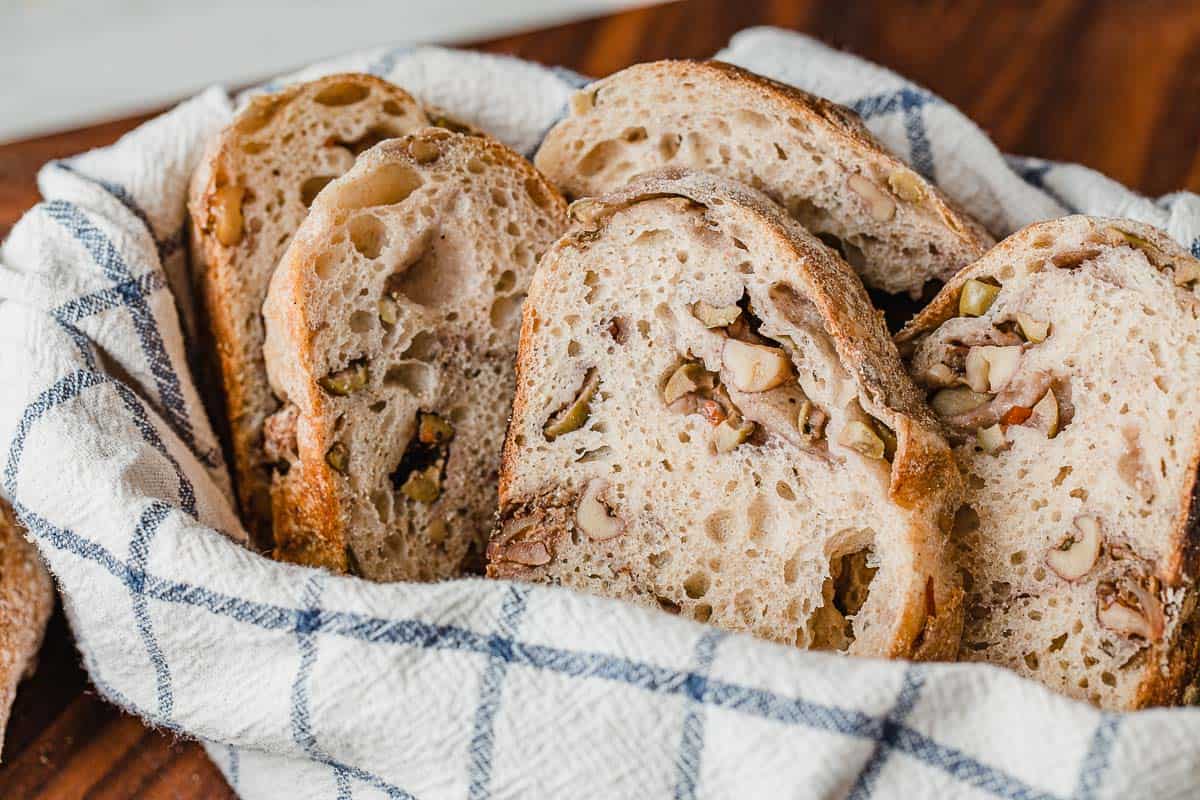
If you live at a high altitude, 5,000-11,500 feet above sea level, you will need to use a sourdough recipe developed for high altitude baking for best results. Visit Butter and Air for their expertise on high altitude sourdough.
Sample baking schedule
- 8 PM: Feed sourdough starter.
- 8 AM: Mix flour, water and starter. Cover and let rest 1 hour. Roast garlic and set aside for later.
- 9 AM: Mix in salt and remaining water. Cover and let rest 1 hour.
- 10 AM: Perform first set of stretch and folds. Cover and let rest 30 minutes.
- 10:30 AM: Add olives, walnuts, roasted garlic and dried herbs. Perform second set of stretch and folds. Cover and let rest 30 minutes.
- 11 AM: Perform third set of stretch and folds. Cover and let rest 2.5 hours. (Kitchen temperature is 70°F)
- 1:30 PM: Dump dough onto floured surface, rough shape into a ball, place in floured proving basket. Cover and let rise 2.5 hours.
- 4 PM: Preheat oven, score and bake.
How to store and freeze
Store your bread at room temperature, wrapped in a kitchen towel or beeswax wrap. You can also store the bread, slice down, on a cutting board with a cake stand top covering the bread.
It is not recommended to store sourdough bread in the fridge as it will become hard.
Freeze full loaves or individual slices wrapped tightly in plastic wrap and inserted into a freezer-safe container for up to 3 months.
Other recipes you may like:
- sourdough focaccia with rosemary and garlic
- sourdough pizza crust
- honey wheat sourdough sandwich bread
- sourdough discard crackers
- jalapeno cheddar sourdough bread
We'd love to hear from you! Give us a shout out in the comment section below. And don't forget to rate our recipe if you try it!

Olive and Walnut Sourdough Bread Recipe
INGREDIENTS
Ingredients to make ½ cup (100 g) of Active Sourdough Starter
- 1 tablespoon (15 g) sourdough starter
- ⅓ cup + 1 tablespoon (50 g) all-purpose flour
- 3 ½ tablespoons (50 g) water
Sourdough Ingredients
- ½ cup (100 g) active sourdough starter
- 1 ½ cups (360 g) water (30 grams divided)
- ⅓ cup + 1 tablespoon (50 g) whole wheat flour
- 3 ¾ cups (450 g) bread flour
- 2 teaspoons (10 g) fine sea salt
Add-in Ingredients
- 1 cup (135 g) sliced olives
- 1 cup (120 g) walnuts (rough chopped)
- 1 teaspoon (5 g) dried basil
- 1 head garlic
- 1 tablespoon olive oil (for roasted garlic)
INSTRUCTIONS
Feed Your Sourdough Starter
- 12 hours before you plan to mix the dough, add the ingredients to make ½ cup (100 g) of active sourdough starter to a clean jar. Stir until combined, loosely cover the jar and let the starter rise at room temperature. (The ingredients will create a total of 115 g active starter but, because some of it will stick to the sides of the jar during the transfer, we are making a little more than needed.) The sourdough starter is ready to use when it has doubled in size and there are plenty of bubbles on the surface and sides of the jar.
Prepare Add-ins
- Roast garlic: Preheat oven to 425°F (218°C). Cut the top of the head of garlic off, drizzle with olive oil and loosely wrap in foil. Bake for 45 minutes. Let cool.
- Add the sliced olives, walnuts, roasted garlic and dried basil to a bowl and set aside.
Make the Dough
- Autolyse: In a mixing bowl, combine 330 grams of water and 100 grams active sourdough starter, stir to combine. Add 50 grams whole wheat flour and 450 grams bread flour and use your hands to combine the ingredients until there are no dry bits and the dough looks like a shaggy mass. Cover the bowl and let the dough rest on the counter for 1 hour.
- Add salt: Add 10 grams of salt to the remaining 30 grams of water in a small bowl and stir to dissolve. Add the salt water to the dough and use your hands to work it in until well combined. Cover the bowl and let rest on the counter for 1 hour.
- Bulk fermentation - Perform 3 sets of stretch and folds, 30 minutes apart, over the first hour and a half. Add the olives, walnuts, roasted garlic and dried basil to the dough during the second set of stretch and folds. Keep the bowl covered between sets.*To perform a set, while the dough is still in the bowl, pick up one side with a wet hand. Pull it up and over itself. Turn the bowl and repeat this action on 4 sides of the dough until the bowl has come full circle. Once finished with the third set of stretch and folds, cover the dough and allow to rise at room temperature for an additional 2-3 hours.
- Shape and Second Rise - Turn the dough onto a floured surface and shape into a rough ball. (It will not be smooth). Flour the top of the dough and place into a floured proving basket, top-side down. Allow to rise at room temperature for 2-3 hours or until it has risen about 20%-30%.
- Score and Bake: Preheat the oven, with the dutch oven inside, to 500°F (260°C) for 30 minutes.Turn the dough out onto a piece of parchment paper and score the top with a razor. Remove the dutch oven and place on stove-top. Use the parchment paper as a sling and lift the dough up and into the dutch oven. Cover, turn oven down to 450°F (232°C) and bake for 20 minutes. Remove the cover and bake an additional 25-30 minutes or until the crust is at the desired color.
- Let the bread cool on a cooling rack for 2 hours before cutting.
NOTES
- Use the scoop and level technique to measure your flour if you do not have a kitchen scale. To do this, use a spoon to fluff up the flour in the bag. Use a spoon to scoop the flour into a measuring cup until it is heaped on top. Take a butterknife and level off the top. This should give you the most accurate measurement for flour.
- Use large silicone gloves when bread baking to protect hands and forearms from burns.
- During the first rise (bulk fermentation), if your kitchen temperature is warmer than 68°F (20°C), check the dough 2 hours after the last stretch and fold to make sure that it does not over proof. The dough is ready for shaping when it has risen about 30% and has bubbles around the edges of the bowl.
- Let the loaf cool completely before slicing to prevent the crumb from becoming gummy in texture.
- Tips for baking in warm and/or high humidity areas - When baking in high humidity and/or warmer areas, it's often a good practice to use less water and bake a little longer than the recipe calls for. Reduce the water by 50 grams in the initial mix and then slowly add the remaining water until you achieve the correct hydration level. Bake the bread about 5-10 minutes longer with the lid on, remove the lid and bake until done. This will take some trial and error!
- Store your bread at room temperature, wrapped in a kitchen towel or beeswax wrap. You can also store the bread, slice down, on a cutting board with a cake stand top covering the bread. It is not recommended to store sourdough bread in the fridge as it will become hard.
- Freeze full loaves or individual slices wrapped tightly in plastic wrap and inserted into a freezer-safe container for up to 3 months.



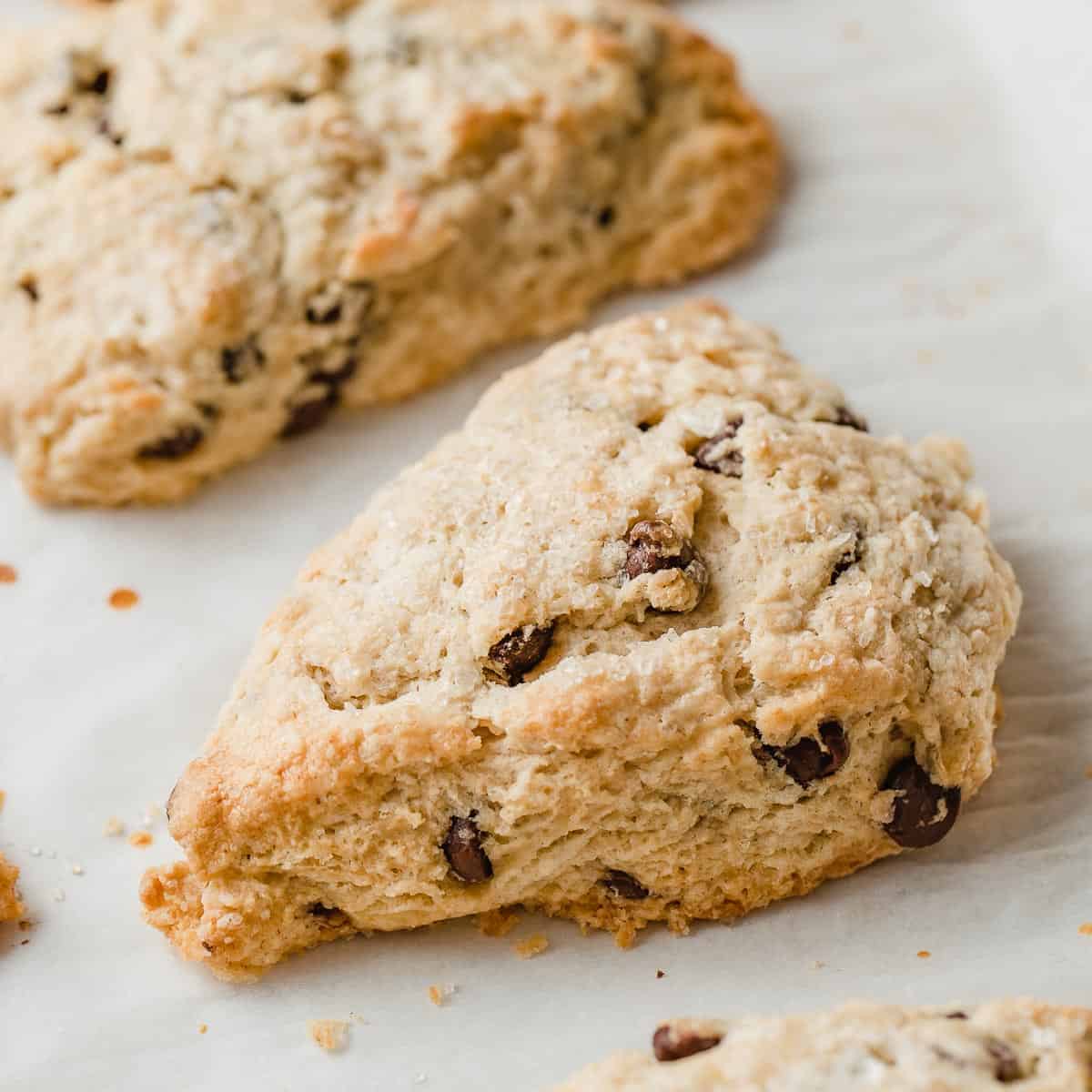

Ronda says
I absolutely love this recipe! All this loaf needs is a pat of butter or a quality olive oil for dipping. I will be making this a lot!
Lina says
I made bread now few times using your recipe. Is so easy and very straightforward. I have tried so many different methods but yours are the best . Thank you
Jillian says
Thank you for this recipe! So easy to follow, and has turned out beautiful results both times I’ve made it (twice in a week, the first loaf went so quickly!) Due to taste preferences, I’ve just used kalamata olives alone as the mix-in and it has turned out great. This is definitely another keeper.
Amy says
This is one of my favorite treats! It's amazing how different add-ins can totally transform sourdough bread!
Desislava says
This is the best sourdough recipe I have ever tried! The bread turned out amazing and I have now baked it several times. Yesterday I tried substituting the add-ins with sundried tomatoes and almonds bit it wasn’t as successful, I blame it on the fact that the tomatoes were too oily… is there something to keep in mind when substituting the olives and/or the walnuts?
Amy says
Yes, you'll want to be careful of using add-ins that are high in moisture and/or oil. That will change the structure of the dough.
DNeida King says
Can you sub more all purpose flour for whole wheat flour in this recipe? Same measurements?
Amy says
Yes you can. Hold back a little water and add it in slowly to avoid too much hydration.
Olive lover says
Best loaf of bread I’ve made yet! Great flavor, rose beautifully. Simple directions, too. Did the rise overnight because of timing. That worked great in my cool kitchen.
Jeff Drake says
URGENT question please!
AT what point can I put the dough into the fridge and let it sit overnight?
After the stretch and folds? After the shaping?
I've just begun making the dough and have to leave unexpectedly. I hate to see this dough wasted. I can return to it tomorrow morning.
Amy Duska says
Jeff, I am so sorry that I just saw your question! I hope you put the dough into the fridge until this morning.
Jeff says
Wow! My wife and I just had a slice of this bread toasted, with a swipe of buckwheat honey, and it blew us away!
This is my second recipe of Amy's in just a couple days. I was so impressed with the result of Amy's sharp-cheddar and jalapeno bread, that I decided to make two more loaves, but with different flavor ingredients. I picked the olive and walnut recipe because we both love those flavors and the idea of this bread just caught my fancy.
I sliced black olives and per the recipe, coarsely chopped the walnuts. Sadly, I didn't have a fresh garlic head, so I substituted with some chopped garlic we get from our favorite Asian market. The garlic flavor of the bread is so mellow! Next time I will definitely roast a head of garlic (Hmm. I'm not sure one head would be enough) as I think that would take this bread to another level.
I decided not to make two loaves of the same bread, so I used roasted red peppers and cheddar cheese in the second loaf. We're waiting till morning to taste it. It was weird to me that I was essentially making two loaves using the same recipe, but the red pepper and cheese dough was noticeably wetter than the olive-walnut dough. And this was before I did the second fold and added the peppers and cheese! I can't figure how that happened. So this made me worry throughout the rest of the process.
But my worry seems to not have been necessary, because the bread looks (and sounds) great! I'm anxious to try it out tomorrow morning. I am planning on making some bruschetta with this bread for lunch tomorrow. Yum!
Thanks, Amy for another keeper!
Lauree Mclain says
can I still make this bread without a proofing basket or dutch oven? can it be shaped on parchment paper and baked on a cookie sheet?
Amy says
You need to proof the dough after shaping in some type of bowl to help the dough keep it's shape as it has it's final rise. You can bake it on a parchment lined baking sheet, however, the loaf will not have as much rise in the oven. The dutch oven acts like a steam oven in the first 20 minutes of baking which helps with oven spring.